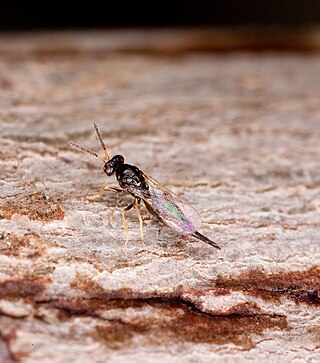
The Eulophidae is a large family of hymenopteran insects, with over 4,300 described species in some 300 genera. The family includes the genus Elasmus, which used to be treated as a separate family, "Elasmidae", and is now treated as a subfamily of Eulophidae. These minute insects are challenging to study, as they deteriorate rapidly after death unless extreme care is taken, making identification of most museum specimens difficult. The larvae of very few species feed on plants, but the majority are primary parasitoids on a huge range of arthropods at all stages of development. They are exceptional in that they are one of two hymenopteran families with some species that are known to parasitize thrips. Eulophids are found throughout the world in virtually all habitats.
Kiggaella is a genus of hymenopteran insects belonging to the family Eulophidae. There is just one described species, Kiggaella oryzae, only known from rice paddies in Karnataka and Kerala states, India.
Achrysocharoides is a genus of hymenopteran insects of the family Eulophidae.

Afrotroppopsis is a monotypic genus of hymenopteran insects of the family Eulophidae.
Baeoentedon is a genus of hymenopteran insects of the family Eulophidae, they are parasitoids of whitefly from the family Aleyrodidae which are found on trees of the genus Ficus. They have been recorded from Australia, China, India, Indonesia and Florida. A fifth species, Baeoentodon farazi, was described from Karnataka, India, in 2017.
Baryscapus is a genus of hymenopteran insects of the family Eulophidae. Species in this genus are endoparasitic, meaning they develop within the body of another insect, with insect hosts being as varied as Hemiptera, Neuroptera, Coleoptera, Lepidoptera, Diptera, or other Hymenoptera.

Closterocerus is a genus of hymenopteran insects of the family Eulophidae.
Emersonella is a genus of hymenopteran insects of the family Eulophidae. Several species are known to be phoretic parasitoids of female tortoise beetles, laying their eggs in the eggs of the beetle host.
Goetheana is a genus of hymenopteran insects of the family Eulophidae. As a parasitoid of thrips, this wasp is used in biological pest control.

Horismenus is a genus of hymenopteran insects of the family Eulophidae occurring primarily in the Americas. As of 2015 over 400 species in the genus have been described. Horismenus species are often described as parasitizing other insects.
Microlycus is a genus of hymenopteran insects of the family Eulophidae.

Minotetrastichus is a genus of hymenopteran insects of the family Eulophidae. They are parasites of leaf-mining Lepidoptera, Coleoptera, and Hymenoptera.

Omphale is a genus of hymenopteran insects of the family Eulophidae. It has cosmopolitan distribution.

Ophelimus is a genus of hymenopteran insects of the family Eulophidae. Members of this genus induce galls on Eucalyptus plants.

Pediobius is a genus of hymenopteran insects of the chalcid wasp family Eulophidae. Like their relatives, the larvae of these diminutive wasps are parasitoids of various arthropods. Some Pediobius are used in biological pest control.

Pnigalio is a genus of hymenopteran insects of the family Eulophidae. Nearly 100 species have been described of which about half may be valid. All species are parasites of other insects. Their biology varies widely among those species that have been studied. Some are ectoparasites, others parasitoid, and still others are hyperparasitoids and their hosts include beetles, flies, hymenopteran and lepidopterans.

Quadrastichus is a genus of hymenopteran insects of the family Eulophidae.
Stenomesius is a genus of hymenopteran insects of the family Eulophidae.

Tetrastichus is a genus of hymenopteran insects of the family Eulophidae.

Tetrastichinae is a subfamily of the chalcid wasp family Eulophidae. It is one of the largest subfamilies of the Eulophidae containing over 100 genera and nearly 3,000 species. The species of the family Tetrastichinae are found in almost any type of terrestrial habitat and have a worldwide distribution, except Antarctica. They show a varied biology and hosts for Tetrastichinae wasps have been identified from over 100 different insect families, across 10 different orders and they have also been recorded as being parasitoids on nematodes, mites and spiders' eggs. Some species are even phytophagous, while others are inquilines and yet others are gall formers.










